
R-Type is a horizontally scrolling shooter arcade video game developed and released by Irem in 1987 and the first game in the R-Type series. The player controls a star ship, the R-9 "Arrowhead", in its efforts to destroy the Bydo, a powerful alien race bent on wiping out all of mankind. The R-9 can acquire a glowing orbicular device called a "Force", protecting it from enemy fire and providing additional firepower. The arcade version was distributed by Nintendo in North America; it is the last arcade title Nintendo distributed.

The TurboGrafx-16, known as the PC Engine outside North America, is a home video game console designed by Hudson Soft and sold by NEC Home Electronics. It was the first console marketed in the fourth generation, commonly known as the 16-bit era, though the console has an 8-bit central processing unit (CPU) coupled with a 16-bit graphics processor. It was released in Japan in 1987 and in North America in 1989. In Europe the Japanese model was unofficially imported and distributed in the United Kingdom and France from 1988. In Japan, the system was launched as a competitor to the Famicom, but the delayed United States release meant that it ended up competing with the Sega Genesis and later the Super NES.

Salamander, retitled Life Force in North America and in the Japanese arcade re-release, is a scrolling shooter arcade video game developed and published by Konami. Released in 1986 as a spin-off of Gradius, Salamander introduced a simplified power-up system, two-player cooperative gameplay and both horizontally and vertically scrolling stages. Some of these later became normal for future Gradius games. In Japanese, the title is written using ateji, which are kanji used for spelling foreign words that has been supplanted in everyday use by katakana. Contra, another game by Konami was also given this treatment, with its title written in Japanese as 魂斗羅.

Air Zonk, known in Japan as PC Denjin, is a horizontally scrolling shooter released for TurboGrafx-16 in 1992. Air Zonk was an attempt to update the company's image via a modern, punkish character called Zonk, who bears a purposeful resemblance to the TurboGrafx-16's caveman mascot, Bonk.
Bonk, known as PC-Genjin in Japan and as PC Kid or B.C. Kid in PAL territories, is a video game character and former mascot for NEC's PC Engine/TurboGrafx-16 video game console. Three platform games featuring the character appeared on the PC Engine/TurboGrafx-16, as well as two spin-offs featuring Air Zonk. The protagonist is a bald caveman named Bonk who attacks using his comically large head.

The TurboDuo is a fourth-generation video game console developed by NEC Home Electronics and Hudson Soft for the North American market. The TurboDuo was test-marketed in Los Angeles in October 1992, before a nationwide rollout in May 1993. It is the North American version of the Japanese PC Engine Duo game console which was released in September 1991.
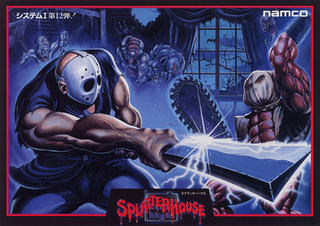
Splatterhouse is a beat 'em up arcade game developed and published by Namco in 1988. It was the first in a series of games released in home console and personal computer formats. This game would later spawn the parody Splatterhouse: Wanpaku Graffiti, the sequels Splatterhouse 2, Splatterhouse 3, and the 2010 remake Splatterhouse, with the classic games being added to Namco Museum since 2017.

Dragon Spirit is a 1987 vertical-scrolling shooter arcade game developed and published by Namco. In North America, it was distributed by Atari Games. Controlling the dragon Amur, the player must complete each of the game's nine areas to rescue the princess Alicia from the demon Zawell. Similar to Namco's own Xevious, Amur has a projectile weapon for destroying air-based enemies and a bomb for destroying ground enemies. It ran on the Namco System 1 arcade board.

Bonk's Revenge, known as PC-Genjin 2 in Japan and PC Kid 2 in Europe, is a 2D platformer set in prehistory, originally for the PC Engine/TurboGrafx-16 console, created in 1991 by the Red Company for Hudson Soft, and licensed by NEC. This is the second title in the Bonk series, and was re-released for the TurboGrafx-16 in 1992 on the Gate of Thunder 4-in-1 game CD-ROM. A completely different game with the same name appeared on the Game Boy, whereas the original version was re-released for Wii Virtual Console and on the Japanese PlayStation Store. It was also released in Japan on Windows Store on December 13, 2013, and on Wii U Virtual Console on March 12, 2014. The title is also playable on the Turbografx-16/PC Engine Mini Console.

Forgotten Worlds, titled Lost Worlds in Japan, is a side-scrolling shooter video game by Capcom, originally released as a coin-operated arcade game in 1988. It is notable for being the first title released by Capcom for their CP System arcade game hardware.
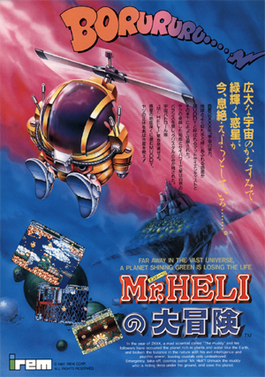
Mr. Heli, fully titled in Japan as Mr. HELI no Daibōken is a multidirectional scrolling shooter developed and published in arcades in 1987 by Irem. It was released in North America as Battle Chopper.

Ninja Spirit, known in Japan as Saigo no Nindou, is a 1988 platform game developed and released in arcades by Irem. Although praised by gamers for detailed graphics, serious themes, solid controls and gameplay, the game also was criticized for its harsh difficulty.
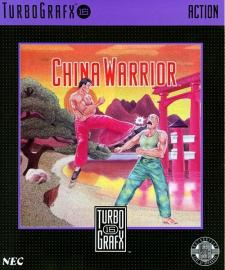
China Warrior, known as The Kung Fu in Japan, is a beat 'em up video game created in 1987 by Hudson Soft for the PC Engine/TurboGrafx-16. The game received mixed reviews upon release, with praise for its large sprite graphics but criticism towards its gameplay.

Gunhed, known as Blazing Lazers in North America, is a vertically scrolling shooter game by Hudson Soft and Compile, based on the Japanese film Gunhed. The title was released in 1989, for the PC Engine in Japan and re-skinned for the TurboGrafx-16 in North America, with Gunhed unofficially imported for the PC Engine in Europe. In the game, a fictional galaxy is under attack by an enemy space armada called the Dark Squadron, and this galaxy's only chance for survival is the Gunhed Advanced Star Fighter, who must destroy the Dark Squadron and its Super Weapons. The gameplay features fast vertical scrolling and a wide array of weapons for the player to use.
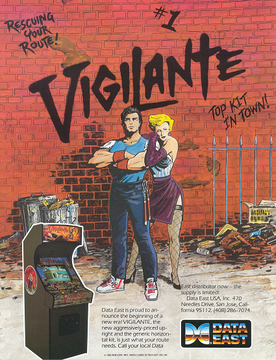
Vigilante (ビジランテ) is a 1988 beat 'em up arcade video game developed and published by Irem in Japan and Europe, and published in North America by Data East. It is considered as a spiritual sequel to Irem's earlier Kung-Fu Master (1984).

Bomberman '93 is a video game in the Bomberman series. It was released on the PC Engine on December 11, 1992 in Japan, with western TurboGrafx-16 releases following in 1993. The game was also re-released for PCs in 2002 alongside the TurboGrafx-16 version of Bomberman and Bomberman World as part of a compilation disc titled Bomberman Collection. The game was re-released for the Virtual Console, with full multiplayer capability intact, for Wii on November 21, 2006 in North America, December 8, 2006 in Europe, and July 6, 2007 in Australia. The game was re-released for the Wii U on December 28, 2016 in Japan, November 30, 2017 in North America and December 14, 2017 in Europe. Bomberman '93 later spawned a sequel titled Bomberman '94.

Chew Man Fu is a 1990 action video game developed by Now Production and published in Japan by Hudson Soft and in North America by NEC for the TurboGrafx-16.
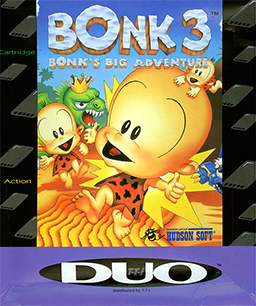
Bonk 3: Bonk's Big Adventure is an action video game released for the TurboGrafx-16 in 1993, the third game in the Bonk video game series.

Liquid Kids is a 1990 platform arcade video game developed and published by Taito. Starring the hippopotamus Hipopo, players travel through the land of Woody-Lake throwing water bombs, jumping on and off platforms to navigate level obstacles while dodging and defeating monsters in order to rescue Tamasun from her captor, the Fire Demon. The game was ported to the PC Engine and Sega Saturn. Home computer versions were in development but none were officially released to the public.

Gate of Thunder is a 1992 scrolling shooter video game developed by Red Company and published by Hudson Soft for the TurboGrafx-CD. It was the first game released in North America to support the Super CD-ROM² format and served as one of the pack-in games for the TurboDuo, a two-in-one system which runs both TurboGrafx-CD and TurboGrafx-16 titles, where it was bundled with Bonk's Adventure, Bonk's Revenge and Bomberman on the same disc. In the game, the player controls the Hunting Dog space fighter craft, piloted by space cop Hawk. Alongside his ally Esty, piloting the Wild Cat support ship, Hawk must stop General Don Jingi and his Obellon armada from obtaining the powerful "Starlight" energy source from planet Aries.




















